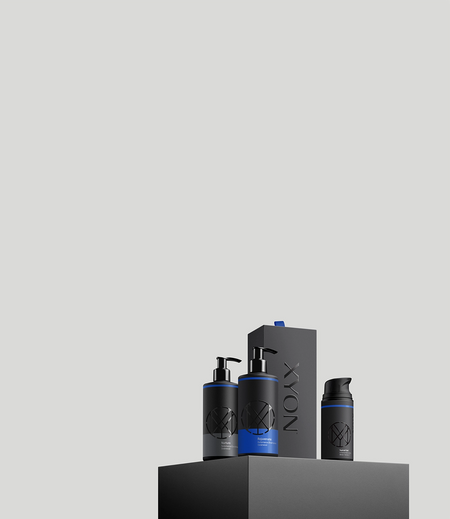Knowing what your hair type can be powerful when it comes to fine-tuning your everyday hair care routine. Not all hair products are created equal and formulators are paying more and more attention to how features like texture and curl pattern can impact styling. Here's your concise guide to the different hair types, why hair texture and porosity matter and general care tips based on your hair's needs. We'll also tackle a key question about maintaining the long-term health of your hair: are some hair types just more prone to hair loss? And do gender and ethnicity affect hair loss risk?
At XYON, we believe in choices when it comes to hair loss treatment.
Whether it's a shampoo or a prescription, we're committed to helping you find the right solution.
Why does hair type matter?
Understanding your hair type can be important when it comes to choosing the right products to nourish your strands and help you achieve your desired hair goals. But what many people forget is that there is more to hair health than just the hair you can see. Let’s break things down, starting with hair types and moving up to the scalp where hair health begins.
What are the different types of hair?
There is no official method for identifying your hair type, but there have been many attempts by stylists to create a standardized system. The Andre-Walker hair-typing system was designed by Oprah Winfrey's hair stylist and aims to break hair types down into the following categories:
This system has received criticism for being limited and restrictive in its categories and it fails to address the multiple other factors that can affect curl patterns, for example different parts of hair can have different textures and the pattern at the front area of hair tends to be different as it’s more exposed to the elements. Let's take a more detailed approach, starting with understanding what makes hair curly.
Genetics are primarily responsible for how curly your hair is. The ‘curly-hair gene’ is a dominant trait meaning that even if only one of your parents has curly hair, you will inherit a curl pattern. Your genes determine the shape of your hair follicle and the shape of your hair follicles determines how curly your hair will be.
More circular-shaped hair follicles produce straighter hair, whilst more oval-shaped hair follicles produce curlier hair. There are special chemical bonds called disulfide bonds that exist in hair strands that further influence the curliness of hair. The more bonds present in the hair, the curlier the hair will be. These bonds are extremely strong, but may be broken by heat and chemical styling, such as straightening and perming or dying your hair. If you want to optimize your natural curl pattern, limiting or avoiding these processes is a good place to start.
In addition to curl pattern, texture and porosity also contribute to your hair type and understanding these concepts can help you to care for your hair in a more targeted way.
What is hair texture?
Most people assume that we have control over hair texture, given how often we refer to hair texture as being ‘oily (greasy)’ or ‘dry’. But this is not the case. Hair texture actually refers to the thickness of individual strands of hair on your head.
Fine hair strands have a small diameter and typically only contain two structural layers: the cuticle and cortex. If it’s difficult to see and feel a single strand of hair between your fingers, you likely have fine hair. This type of hair can be more prone to breakage, so it may be beneficial to avoid damaging processes, such as excessive heat when styling.
Coarse hair strands have a larger diameter and contain an extra structural layer, known as the medulla. If you can easily feel a single strand of hair between your fingers and the strand has a wiry appearance, you likely have coarse hair. This type of hair can typically tolerate higher levels of heat during styling, but it may be more prone to frizz so using hair oils can be beneficial. Leave-in conditioning products can also be a good way to nourish and soften coarse hair.
What is hair porosity?
As mentioned above, single hair strands contain different structural layers and it’s the cuticle layer that determines the porosity of hair. Made up of overlapping cells, the cuticle is responsible for protecting your hair from damage and it determines how easily your hair absorbs and retains moisture from products and environment.
When the cuticle layer is damaged from hair dye, heating tools and other damaging processes, gaps can form in the overlapping cells of the cuticle. This type of hair is highly porous, which means that it can absorb moisture more easily, but struggles to retain it. When it comes to caring for high porosity hair, the goal is to help your hair retain moisture and heal the cuticle layer. Moisturizing products, such as those containing oils and butters may help to seal the cuticle layer and keep the hair nourished.
If you have minimally porous hair, it’s a good idea to apply products to warm and wet hair, because this will help to lift the cuticle layer, helping products to be absorbed into the strands more effectively. Looking for ingredients that effectively penetrate the cuticle layer, such as coconut oil and argan oil can also be beneficial in helping the hair to absorb moisture.
If you’re not sure whether you have porous hair, there is an easy at home test that you can do. Place a loose strand of hair into a cup of water. If the strand sinks straight away, it has high porosity. If it floats initially before sinking, it has low porosity.
Are male hair types and female hair types different?
No, male and female hair types are the same. Although hair type is partially determined by genetics, the responsible genes aren’t influenced by gender. But what can differ are the cultural norms surrounding how healthy and/or desirable hair should look. Men's hair products tend to be designed to achieve a more matte finish that holds the hair in place, whilst female products are typically formulated to promote shine and volume. This can give us the perception that men and women’s hair types are different.
Hair types and risk of hair loss
Understanding your hair type may help you to achieve your desired goals when it comes to styling and appearance, but can it help to minimize your risk of hair loss?
Unfortunately not. No matter how well you care for your hair, you may still be at risk of developing hair loss. Androgenetic alopecia (also known as male pattern baldness) is the most common type of hair loss in men and it can happen to anyone. However, there are some people that may be at a higher risk.
Understanding what causes hair loss may help to ease some of the pressures you might be feeling about perfecting your hair care routine.
What causes androgenetic alopecia?
Androgenetic alopecia is predominantly caused by a hormone called dihydrotestosterone (DHT), which is converted from testosterone. High levels of DHT at the scalp can cause the hair follicles to shrink and produce thinner, more brittle strands of hair (in a process known as miniaturization). Eventually, the hair follicles are unable to produce viable hair strands which leads to balding. There is continuous research into the genetics of male pattern baldness and currently available data tells us that inheritance plays a big role and studies have found that 80% of predispositions to male pattern baldness are due to inherited genes (
Heath et al, 2003).
Ethnic background can also influence the risk of hair loss. Research suggests that Caucasian males are most likely to experience androgenetic alopecia, whilst those of Asian and African descent are less likely (
Stough et al, 2005). This may lead to the misconception that hair type can influence hair loss, due to certain hair types also being more prevalent within different ethnicities. But based on the medical evidence so far, the two factors do not seem to be linked.
How to manage hair loss
You have many options when it comes to treating hair loss and we recommend you seek professional medical advice at the first signs of thinning hair. DHT-blocking drugs such finasteride and dutasteride can be an effective treatment for androgenetic alopecia and they work by lowering DHT levels to prevent shrinkage of hair follicles. Using hair products suited to your hair type alongside hair loss treatment may improve the appearance of your hair and help you to feel more confident throughout your hair loss journey.
Takeaway: hair types and hair loss risk
Knowing your hair type can help point the direction towards hair products that can bring out your hair’s best. But this is just one part of the hair and scalp health equation. To ensure that your hair looks great for as long as possible, you’ll also want to be aware of your risk for pattern hair loss. Fortunately, hair type doesn’t seem to factor into this, but genetics are significant. If you have a family history of balding, or have started to notice early signs of thinning hair (e.g. a receding hairline), consider talking to a doctor to see if you might benefit from treatment.
References List
Heath, A.C., Nyholt, D.R., Gillespie, N.A., Martin, N.G. (2003). Genetic basis of male pattern baldness. Journal of Investigative Dermatology, 121(6), 1561-1564. https://doi.org/10.1111/j.1523-1747.2003.12615.x
Stough, D., Stenn, K., Haber, H., Vogel, J.E., Whiting, D.A., Washenik, K., Parsley, W.M. (2005). Psychological effect, pathophysiology and management of androgenetic alopecia in men. Mayo Clinic Proceedings, 80(10), 1316-1322. https://doi.org/10.4065/80.10.1316







